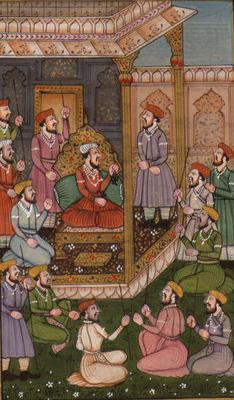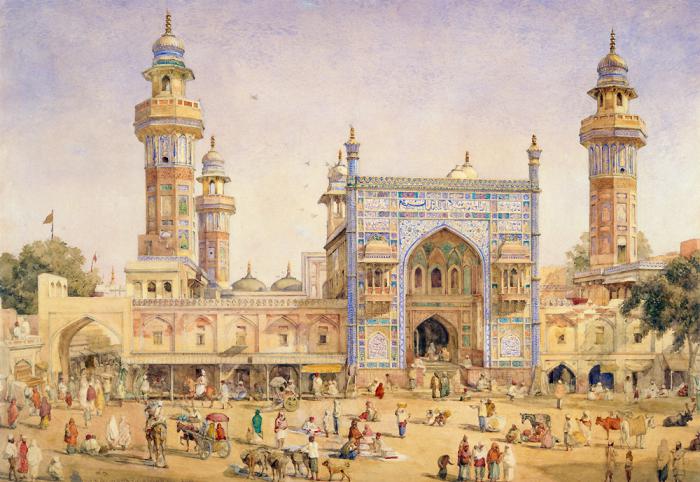India is one of the largest countries in the world with a distinctive culture and an interesting history. In particular, to this day researchers are concerned with the question of how the son of the emir of Fergana Babur, left without a father at the age of 12, not only did not become a victim of political intrigue and died, but also penetrated India and created one of the greatest empires in Asia. .
Background
Before the mighty Mughal empire was formed on the territory of modern India and some adjacent states, this country was fragmented into many small principalities. They were constantly raided by nomad neighbors. In particular, in the 5th century the Hun tribes penetrated the territory of the Gupta state, which occupies the northwestern part of the Hindustan Peninsula and adjacent to the north,. And although by the 528th year they were expelled, after their departure in India there were no large state formations. A century later, several small principalities united under their leadership the charismatic and visionary ruler of Kharsh, but after his death the new empire broke up, and in the 11th century Muslims invaded the territory of Hindustan under the leadership of Mahmoud Ghaznevi and founded the Delhi Sultanate. During the 13th century, this state was able to withstand the invasion of the Mongols, but by the end of the 14th it collapsed as a result of the invasion of the thousands of hordes of Timur. Despite this, the largest principalities of the Delhi Sultanate lasted until 1526. The Great Mughals became their conquerors, led by Babur, Timurid, who came to India with a huge international army. His army at that time was the strongest in the region and the forces of the Indian Rajas could not prevent him from conquering Hindustan.
Biography of Babur

The first Mughal of India was born in 1483 in the territory of modern Uzbekistan, in the famous trading city of Andijan. His father was the emir of Ferghana, who was the great-great-grandson of Tamerlane, and his mother came from the Genghisids. When Babnur was only 12 years old, he remained an orphan, but after 2 years he had already managed to capture Samarkand. In general, as researchers of the biography of the founder of the Mughal empire indicate, he had an exceptional desire for power from early childhood, and even then he cherished the dream of becoming the head of a huge state. The triumph after the first victory did not last long, and after 4 months Babur was expelled from Samarkand by Sheybani Khan, who was three times older than him. An experienced politician did not calm down on this and ensured that young timurid was forced to flee with the army to Afghanistan. There fortune smiled at the young man, and he conquered Kabul. But the insult that the new Uzbek ruler ruled his fiefdom - Samarkand, did not give him rest, and he repeatedly made attempts to return to this city. All of them ended in failure, and realizing that there was no turning back, Babur decided to conquer India and establish his new state there.
How the Mughal State was founded
In 1519, Babur made a trip to Northwest India, and after 7 years decided to capture Delhi. In addition, he defeated the Rajput prince and founded a state with a center in Agra. Thus, by the year 1529, the empire included the territories of East Afghanistan, Punjab and the Ganges valley up to the borders of Bengal.
The death of Babur
Death overtook the founder of the Mughal empire in 1530. After the accession to the throne of Hamayun, the Mughal empire in India lasted until 1539, when the Pashtun commander Sher Shah expelled him from the country. However, after 16 years, the Mughals were able to regain their possessions and return to Delhi. Anticipating his imminent demise, the head of state divided the empire between his four sons, appointing Hamayun, who was to rule Hindustan, as the main one. The three other baburids went to Kandahar, Kabul and Punjab, but they were required to obey their older brother.
Akbar the Great
In 1542, a son was born to Hamayun. He was called Akbar, and it was precisely this grandson of Babur who had to make the empire founded by the Great Mughals go down in history as an example of a state where there was no religious or national discrimination. He ascended the throne, almost at the same early age as his grandfather, and spent almost 20 years of his life on the suppression of rebellions and the strengthening of centralized power. As a result, by 1574, the formation of a single state with clear local government and tax collection systems was completed. An exceptionally intelligent man, Akbar the Great allocated land and financed the construction of not only mosques, but also Hindu temples, as well as Christian churches, which missionaries were allowed to open in Goa.
Jahangir
The next ruler of the empire was the third son of Akbar the Great - Selim. Having ascended the throne after the death of his father, he ordered to call himself Jahangir, which means “conqueror of the world”. He was a short-sighted ruler who first repealed the laws regarding religious tolerance, thereby setting Indians and other non-Muslim peoples against himself. Thus, the Great Mughals ceased to enjoy the support of the population of many regions, and were forced from time to time to suppress the uprisings against their Raja henchmen.
Shah Jahan
The last years of the reign of Jahangir, who became an addict towards the end of his life, were a gloomy time for the empire that the Great Mughals founded. The fact is that a struggle for power began in the palace, in which the main wife of a padishah named Nur-Jahan actively participated. During this period, the third son of Jahangir, married to his stepmother's niece, decided to take advantage of the situation and achieved the proclamation of himself as an heir bypassing the older brothers. After the death of his father, he ascended the throne and reigned for 31 years. During this time, the capital of the Great Mughals - Agra has become one of the most beautiful cities in Asia. At the same time, it was he who decided in 1648 to make Delhi the capital of his state and built the Red Fort there. Thus, this city became the second capital of the empire, and it was there that in 1858 the last Great Mogul was taken prisoner by British troops along with his immediate family. Thus ended the history of the empire, which left behind a huge cultural heritage.

The capital of the Mughals
As already mentioned, in 1528 Babur made Agra the main city of his empire. Today it is one of the most famous tourist centers of Asia, as many monuments of architecture of the Mughal period have been preserved there. In particular, everyone knows the famous Taj Mahal mausoleum, built by Shah Jahan for his beloved wife. This unique building is rightfully considered one of the wonders of the world and impresses with its perfection and magnificence.
The fate of Delhi was completely different. In 1911, it became the residence of the Viceroy of India, and all the main departments of the colonial British government moved there from Calcutta. Over the next 36 years, the city developed rapidly, and there appeared areas of European development. In particular, in 1931, the opening of his new district of New Delhi, completely designed by the British, took place. In 1947, he was proclaimed the capital of the independent Republic of India and remains so to this day.
The Mughal Empire lasted from the first half of the 16th to 1858 and played a crucial role in the fate of the peoples inhabiting India.